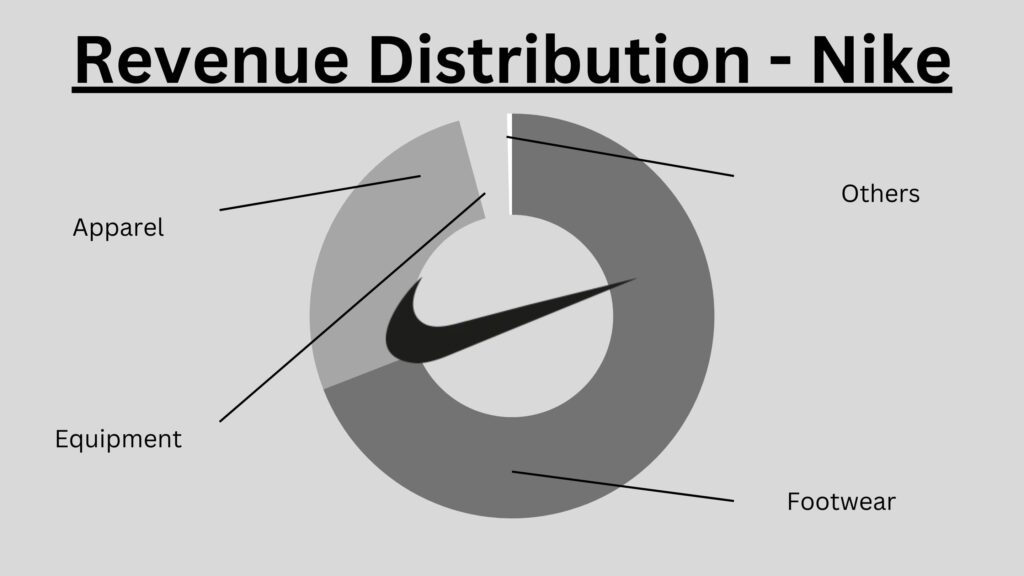Nike, Inc., commonly known as Nike, is an American multinational corporation renowned for its athletic footwear, apparel, equipment, and services. Founded in 1964 by Bill Bowerman and Phil Knight, Nike has evolved into one of the world’s leading sports brands. To fully appreciate Nike’s business model and the sectors driving its financial success, it’s essential to examine the distribution of its revenue. This article delves into Nike’s various revenue streams, highlighting the diverse segments that contribute to the company’s overall economic health.
Overview of Nike’s Business Segments
Nike operates through several business segments, each contributing significantly to its revenue. These segments include:
- Footwear
- Apparel
- Equipment
- Others
Footwear
Footwear is the backbone of Nike’s business model, generating the majority of the company’s revenue. This segment encompasses various products and lines, including:
- Performance Shoes: Designed for specific sports and athletic activities, such as running, basketball, soccer, and training.
- Lifestyle Shoes: Casual footwear that blends style and comfort, often inspired by athletic designs.
- Collaborations and Limited Editions: Exclusive and often high-demand products developed in partnership with designers, athletes, and other brands.
Apparel
The apparel segment is another major contributor to Nike’s revenue, offering a wide range of products for various sports and everyday wear. This segment includes:
- Performance Apparel: Clothing designed for athletic performance, such as Dry-FIT technology for moisture-wicking.
- Lifestyle Apparel: Casual and stylish clothing that can be worn both for sports and everyday activities.
- Teamwear and Uniforms: Customized apparel for sports teams and leagues, including official merchandise.
Equipment
Nike’s equipment segment includes a diverse array of products designed to support athletic activities. This segment covers:
- Sporting Goods: Items such as balls, gloves, and bats for various sports.
- Fitness Equipment: Products like weights, yoga mats, and resistance bands for personal and gym use.
- Accessories: Items such as bags, socks, hats, and digital devices like fitness trackers and smartwatches.
Others
The ‘Others’ segment includes various initiatives and ventures that contribute to Nike’s overall business, such as:
- Nike Digital: Platforms like Nike.com and the Nike App, which provide a seamless shopping experience and exclusive content.
- Nike Direct: Direct-to-consumer sales through Nike’s own retail stores and online platforms, enhancing customer engagement and brand loyalty.
- Sustainable Innovation: Nike’s efforts in developing eco-friendly products and sustainable practices, aligning with the growing consumer demand for responsible brands.
By understanding these segments, one can grasp the diverse sources of Nike’s revenue and their impact on the company’s financial health.
Nike’s Revenue Distribution Analysis
As of the latest financial reports, Nike’s revenue distribution is as follows:

Footwear
Footwear remains the largest revenue generator, accounting for approximately 69.1% of total revenue. This segment is driven by Nike’s wide range of performance and lifestyle shoes, including popular lines like Air Max, Jordan, and Air Force. The brand’s strong reputation for quality and innovation in athletic footwear continues to attract a large consumer base globally.
Apparel
Apparel is Nike’s second-largest revenue stream, contributing around 26.7% of total revenue. This segment includes performance apparel designed for various sports and activities, as well as lifestyle clothing that appeals to fashion-conscious consumers. The combination of functionality and style helps Nike maintain a competitive edge in the apparel market.
Equipment
The Equipment segment accounts for approximately 3.8% of Nike’s total revenue. This category includes sporting goods such as balls, gloves, and fitness accessories, which support a wide range of athletic activities. Despite being a smaller portion of the overall revenue, Nike’s equipment segment plays an essential role in providing comprehensive solutions for athletes.
Others
The ‘Others’ segment contributes around 0.4% to Nike’s total revenue. This category encompasses various initiatives and ventures, including Nike Digital and sustainable innovation efforts. Although relatively small, this segment highlights Nike’s commitment to enhancing customer experiences and driving future growth through technological advancements and eco-friendly practices.
Financial Performance and Growth Trends
Nike’s financial performance has been marked by consistent growth across its diverse business segments, driven by strategic initiatives, market expansion, technological innovation, and effective brand integration. Here’s a concise analysis of the financial performance and growth trends of Nike.
E-commerce Expansion
Global E-commerce Market: Nike dominates the global athletic market through its online platforms, including Nike.com and the Nike App, benefiting from increasing internet penetration and a growing preference for online shopping. The company’s direct-to-consumer (DTC) strategy has expanded its customer base and enhanced brand loyalty.
International Reach: Nike’s e-commerce platforms are popular in regions such as North America, Europe, and Asia, allowing the company to reduce its dependence on traditional retail channels and establish a strong global footprint. The integration of digital innovation, like personalized shopping experiences and exclusive online releases, supports this growth.
Footwear
Innovation and Technology: Nike’s footwear segment is a critical growth driver. The company continuously innovates with new technologies such as Flyknit, Air Max, and React cushioning systems, contributing significantly to Nike’s revenue. High-profile collaborations and limited-edition releases also bolster brand visibility and sales.
Apparel
Performance and Lifestyle Apparel: Nike’s apparel segment is another major contributor to its financial performance. The company offers a wide range of products designed for sports and everyday wear, incorporating advanced materials like Dri-FIT for moisture management. Nike’s ability to blend performance with style helps maintain its competitive edge.
Equipment
Comprehensive Athletic Solutions: The equipment segment, while smaller, is essential for providing athletes with a complete range of sporting goods, fitness accessories, and digital devices like fitness trackers. This segment supports Nike’s mission to cater to all aspects of an athlete’s needs.
Innovation Initiatives and Others
Forward-Looking Strategy: Nike’s commitment to innovation is evident in its investments in emerging technologies and sustainability. Key initiatives include:
- Nike Digital: Enhances customer experience through digital platforms and personalized services.
- Sustainable Innovation: Focuses on developing eco-friendly products and sustainable manufacturing practices.
Strategic Investments and Acquisitions
Enhancing Core Businesses: Nike’s strategic investments and acquisitions bolster its core businesses and expand its capabilities. Notable investments include:
- Nike Direct: Strengthens the direct-to-consumer approach, enhancing customer engagement and loyalty.
- Sustainable Ventures: Investments in sustainable practices and eco-friendly materials support Nike’s long-term commitment to environmental responsibility.
Nike’s strategic focus on innovation, digital transformation, and sustainability positions the company for continued growth and leadership in the global athletic market.
Conclusion
In conclusion, Nike’s diverse revenue distribution showcases the company’s robust and dynamic business model. The substantial contribution of the footwear segment, which accounts for 69.1% of total revenue, underscores Nike’s dominance and innovation in athletic footwear. The apparel segment, contributing 26.7%, highlights the brand’s ability to blend performance with style, appealing to a broad range of consumers. Although smaller, the equipment segment plays a crucial role in providing comprehensive solutions for athletes, accounting for 3.8% of revenue. The ‘Others’ segment, though only 0.4%, reflects Nike’s commitment to future growth through digital platforms and sustainable innovation.
Nike’s consistent financial growth is driven by strategic initiatives, market expansion, technological innovation, and effective brand integration. The company’s e-commerce expansion, both globally and within specific regions, enhances customer engagement and loyalty. Investments in emerging technologies and sustainability further position Nike as a leader in the global athletic market.
By understanding the distribution of Nike’s revenue and the strategic efforts behind its financial performance, we gain insight into the company’s ongoing success and its future potential. Nike’s focus on innovation, direct-to-consumer strategies, and sustainable practices ensures its continued leadership and growth in the competitive world of sports and athletics.



